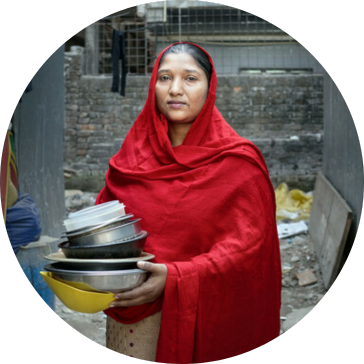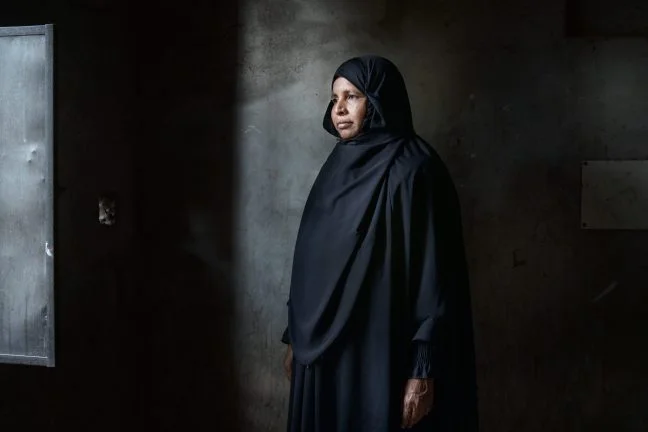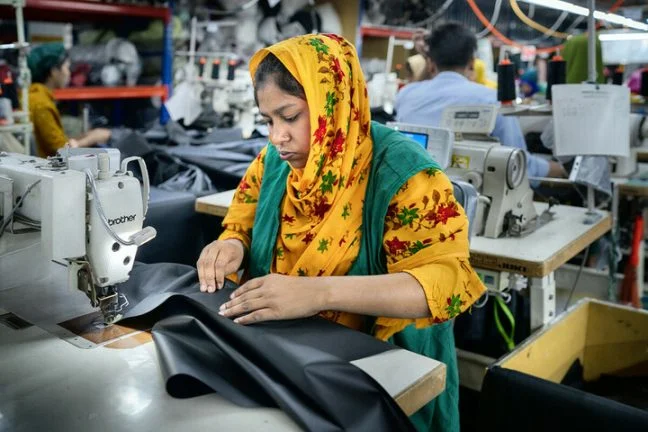About the campaign
Big brands are keeping the women who make our clothes living in poverty.
The women who make our clothes do not make enough to live on – keeping them in poverty. Despite long hours away from their families, working full time plus many hours of overtime, big clothing brands do not pay garment workers enough money to cover the basics of life – food and decent shelter.
Oxfam’s What She Makes campaign demands big clothing brands pay the women who make our clothes a living wage. Together, with your voice demanding action, and Oxfam’s direct engagement with brands, we urge clothing companies to take the crucial next step in creating a fairer fashion industry.
Overview

On average, just 4% of the price of a piece of clothing sold in Australia goes toward workers’ wages in garment factories.

If brands absorbed the cost of paying living wages within their supply chains, it would cost them less than 1% of the price of a garment.

By not paying a living wage, big brands are keeping the women who make our clothes in poverty.
Brands must publicly commit to paying living wages.
Right now, big brands are part of a system that pays poverty wages. It is particularly unfortunate that this system persists in a time of pandemic when the industry has grown yet many garment workers are finding it harder than ever.
It is now time for brands to publicly commit to paying living wages. Brands must develop credible, transparent, time-bound plans to map out how they will achieve this goal.
A living wage is not a luxury or a privilege, it is a universal human right for every working person around the world, including the women who make our clothes.
We are all cut from the same cloth. We are people who care about how our clothes are made.
Together, we stand with the women who make our clothes and demand big brands pay a living wage. Make brands rethink #WhatSheMakes, Sign the Pledge today
Frequently Asked Questions
What is a “living wage”?
A living wage should be earned in a standard workweek (no more than 48 hours) by a worker, and be sufficient to afford a decent standard of living for the worker and their family.
Elements of a decent standard of living include food, housing, healthcare, clothing, education, transportation, energy and water. It also includes some money that can be put aside for unexpected events.
Oxfam is calling on the companies behind the leading and iconic clothing brands to commit to paying a living wage to the workers making their clothes – and to publishing a step-by-step strategy outlining how and when this will be achieved.
Brands have the power and responsibility to ensure the women who make our clothes can live decent lives and lift themselves out of poverty.
Will I need to pay more for clothes?
It would cost less than 1% of the retail price (that’s less than 10 cents for a $10 T-shirt) for brands to do the right thing and pay a living wage to the women who make our clothes.
Oxfam is not suggesting that the cost should be passed on to consumers. Oxfam argues there is enough profit and other margins within the supply chains of big brands to mean that they can pay living wages, without creating higher prices for people who buy clothes.
Should we boycott brands who fail to pay a living wage?
Oxfam does not advocate boycotts, as this may result in workers losing their jobs. The garment industry is an important part of the economy in many developing countries – and we want this to remain the case.
We’re asking that the jobs in the garment industry are fair and safe – and that people are paid a living wage for the work that they do. Together, we can use our power as customers to tell companies we care about the women who make our clothes, and ask them to commit to paying a living wage.
We encourage people who buy clothes to think about how best to influence the brands they purchase, including taking into account companies’ responses to requests to commit to a living wage.
Which brands are ethical?
Oxfam is not focused on providing advice on which brands are ethical and don’t provide advice on ethical clothing. We campaign to ensure as many workers as possible are paid a living wage.
While many Australian brands enjoy increases in revenue, the workers making our clothes – the vast majority of whom are women – are trapped in a cycle of poverty.
Initially, 17 companies and their brands are a part of Oxfam’s campaign. They include the largest and most well-known Australian fashion retailers and department stores, as well as international brands H&M and Zara, who are pushing into the Australian market.
Check out the Company Tracker to see how the brands are going.
How can we make a difference?
Brands listen to us, because we buy their clothes.
History shows that when people care about the conditions in garment factories around the world, brands listen. After the tragic Rana Plaza factory building collapse in Bangladesh in 2013, Australian consumers demanded that companies act on factory safety. In response, almost all of the largest garment retailers in Australia joined the ground-breaking Bangladesh Fire and Building Safety Accord.
Similarly, as Oxfam and others focused on the push for transparency in the clothing industry and bringing factory lists out of hiding, Australians again took to email and social media to express their opinions directly to brands. In the past five years, 20 of the biggest brands operating in Australia have published the majority of their factory locations online – keeping them accountable when problems occur.
Sign the pledge right now, to tackle poverty in the fashion industry and let clothing brands know that the women who make our clothes must be paid a living wage

